Raised Herb Garden Ideas: Creative and Simple Solutions
If you enjoy cooking with fresh herbs, building a raised herb garden can be a great way to have easy access to your favorite flavors right at home. It’s a flexible option that suits both beginners and seasoned gardeners alike, offering convenience and aesthetic appeal to any outdoor or indoor space.
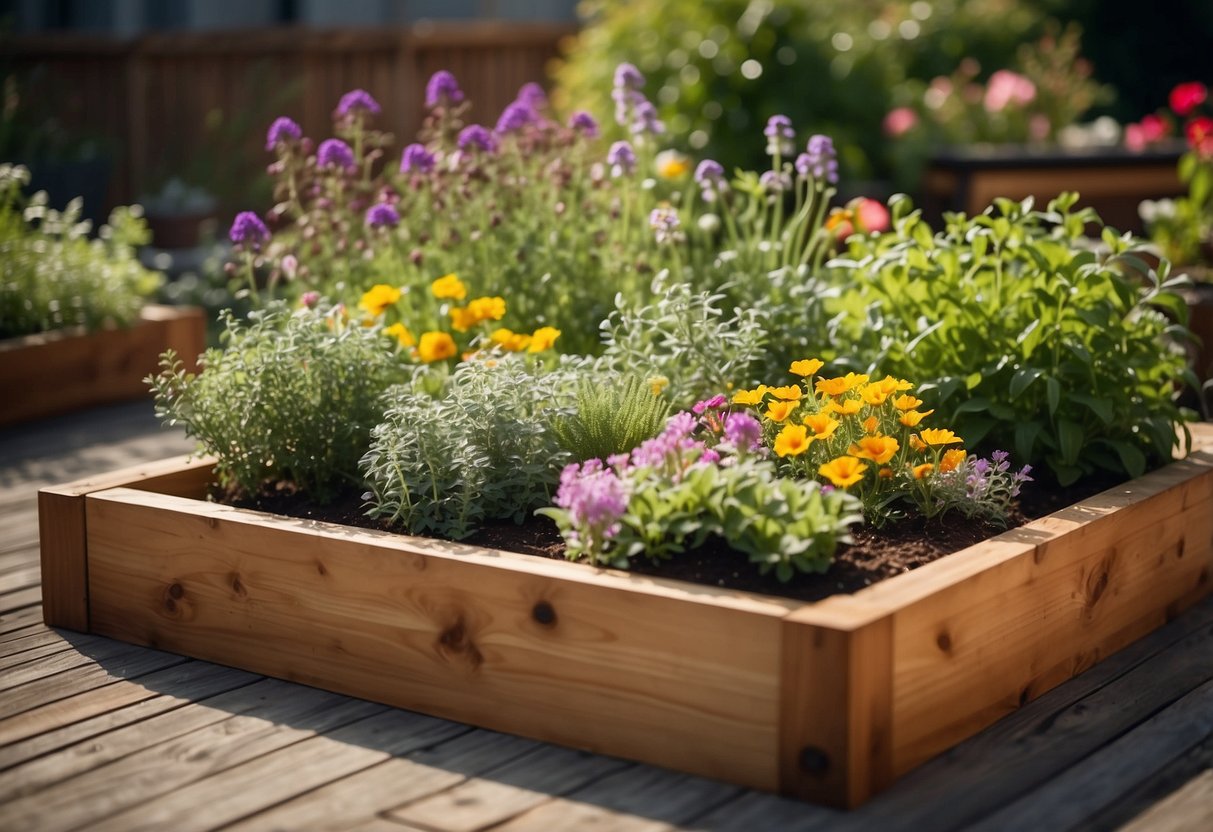
You’ll find that a raised herb garden not only maximizes your gardening space but also makes maintenance much easier. From selecting the best herbs to grow to choosing the right materials for your garden bed, there are many exciting possibilities to explore. With the right tips and ideas, you can create a thriving herb garden that brings fresh and flavorful ingredients to your kitchen year-round.
1) Classic Wooden Raised Bed

Creating a classic wooden raised bed for your herbs is a fantastic idea. Wood is a natural and attractive material that blends well with any garden style.
When choosing wood, look for rot-resistant options like cedar or redwood. These types of wood ensure the longevity of your raised bed.
You can design your classic wooden raised bed to fit any space. Whether it’s a small backyard or a larger garden area, the flexibility in size and shape makes wooden beds a great choice. Plus, they help keep your herbs neatly contained and easy to manage.
2) Galvanized Metal Planter

Galvanized metal planters are a stylish and durable option for your raised herb garden. These containers are resistant to rust and can last for many years, making them a great investment.
To set up, drill several drainage holes in the bottom to prevent water from accumulating. Elevate your tub using pavers for better drainage and airflow.
You can find more ideas for using galvanized metal planters here.
3) Vertical Pallet Herb Planter

A vertical pallet herb planter is a great way to grow herbs in a small space. You can use an old wooden pallet to create a charming and functional garden.
Organize your herbs by painting the pallet with chalkboard paint. This lets you label each section with chalk, so you know exactly what’s growing where.
Another fun idea is to repurpose a pallet into a mobile herb garden that you can move around your yard or patio. It’s a perfect project for a weekend afternoon. For more inspiration, check out these DIY pallet garden ideas.
4) Cinder Block Garden

Using cinder blocks for a raised herb garden is a simple and practical idea. These blocks are sturdy and affordable. You can easily find them at most hardware stores.
You arrange the blocks in a rectangle or square, depending on your space. This creates a perfect frame for your herbs. Cinder blocks also provide good drainage for the plants.
You can plant herbs like basil, rosemary, and thyme in the spaces between the blocks. These small pockets are great for growing smaller herbs. Using cinder blocks is a creative way to build a durable and useful herb garden in your backyard. For more ideas, see cinder block garden.
5) Wheeled Garden Cart
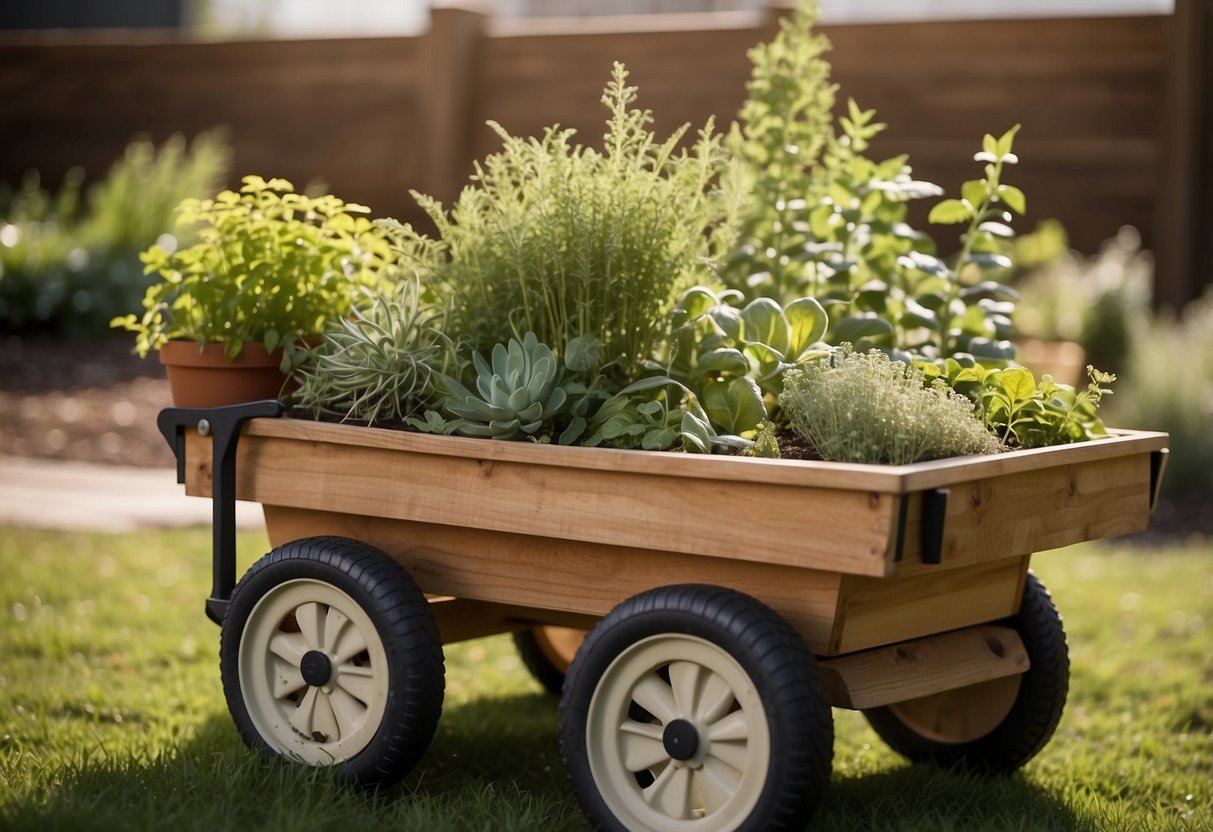
A wheeled garden cart is a perfect solution for moving your herbs around effortlessly.
These carts are great for adjusting the amount of sunlight or shade your herbs receive.
You can find DIY plans for making a sturdy wheeled garden cart, which often features additional storage for tools and supplies.
Explore more about DIY garden carts here.
6) Repurposed Drawer Planter

Turning an old dresser drawer into a planter is a fun and easy project. Just remove the drawer from the dresser, paint it however you like, and add some holes for drainage.
Fill the drawer with soil and plant your favorite herbs. Put it in a sunny spot where it can get at least six to eight hours of sunlight a day.
This idea is great for small spaces. You can place your repurposed drawer planter on a patio, deck, or even a balcony. It’s an eco-friendly way to grow herbs while giving new life to old furniture.
7) Tiered Ladder Planter
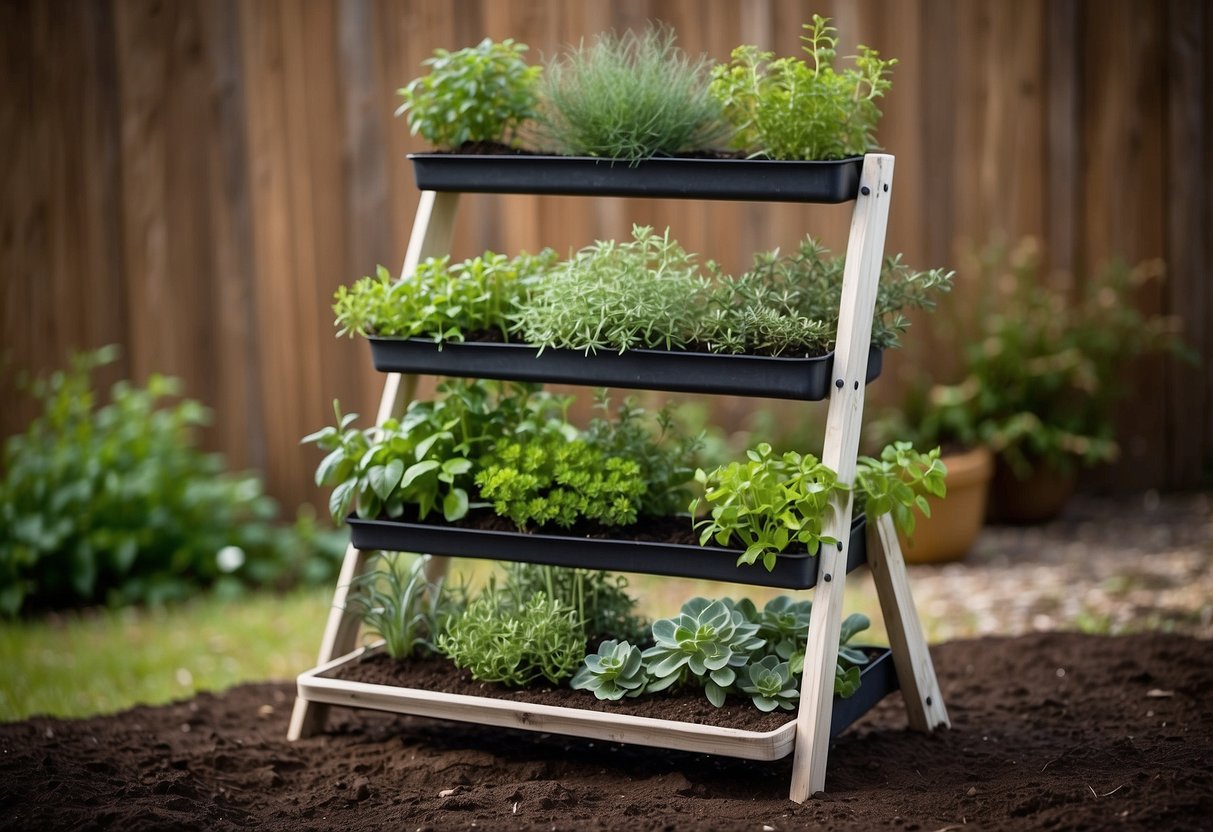
A tiered ladder planter is a fun and practical way to grow your herbs. You can use an old ladder and a few wooden planks to create several levels for your plants.
This setup not only looks charming but also saves space. It’s perfect for small patios or balconies.
You can also paint the ladder to match your decor or give it a rustic look for added charm. A tiered ladder planter offers easy access to your herbs, making it a convenient option for any gardener.
8) Wine Barrel Garden

Using a wine barrel for your herb garden is a fantastic idea. It adds a rustic charm to your space and provides ample room for your favorite herbs.
Wine barrels are perfect for container gardening. They offer great moisture retention and space for roots to grow.
You can transform a wine barrel into a unique planter with some drainage holes and quality soil. This setup works well for herbs like basil, thyme, and rosemary.
9) Wall-Mounted Herb Boxes

Wall-mounted herb boxes are perfect for small spaces. You can easily set them up on any wall in your kitchen, balcony, or even living room. This way, you always have fresh herbs at your fingertips.
Consider installing sturdy boxes that can hold enough soil for your herbs to thrive. Using lightweight materials like plastic or wood can make installation simpler.
For a modern touch, try sleek, Danish-designed planters as seen here. This design is great for apartments with limited space.
Make sure your wall-mounted herb boxes get plenty of light. Place them near a sunny window or use grow lights.
10) Patio Herb Table
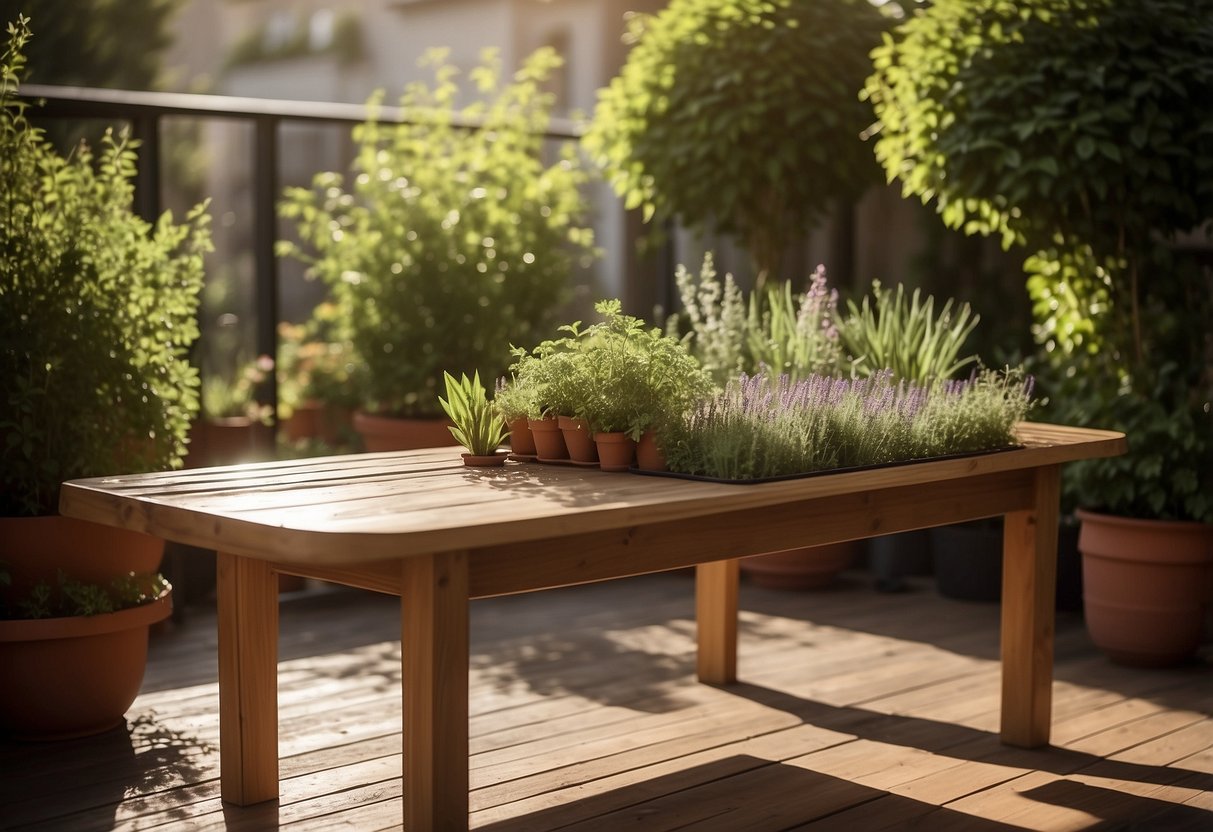
A patio herb table is a great way to keep fresh herbs within reach.
With a flat surface and multiple compartments, it allows you to grow a variety of herbs like basil, rosemary, and parsley.
Position it close to your kitchen door for easy access while cooking.
You can also add some small potted flowers for a decorative touch.
For more ideas, check out these herb garden plans.
Benefits of Raised Herb Gardens

Raised herb gardens offer several advantages, including ease of access and improved soil quality, which can make gardening more enjoyable and productive.
Easier Access and Maintenance
One of the main benefits of raised herb gardens is easier access. Because the beds are elevated, you don’t need to bend over as much, which can reduce strain on your back and knees. This setup is especially helpful for those with physical limitations.
Raised beds also make weeding and harvesting simpler. The confined space makes it harder for weeds to invade, and you can easily reach and care for your herbs. Watering becomes more efficient too, as the elevated soil drains better, reducing the risk of overwatering.
Improved Soil Quality
Raised herb gardens give you more control over the soil quality. You can choose the best soil mix for your herbs, ensuring they have the right nutrients to thrive. It also allows you to avoid using the less fertile or compacted soil found in your yard.
Soil in raised beds warms up faster in the spring, extending the growing season. This can be particularly advantageous if you live in cooler climates. You’ll find that managing pests and diseases is simpler too because the isolated bed can be more easily monitored and treated.
The improved soil quality can lead to healthier, more robust herbs that are better suited for cooking and other uses.
Designing Your Raised Herb Garden

Creating your own raised herb garden can be fun and rewarding. To get started, think about where to place your garden, what materials you’ll need, and how to make it look nice.
Choosing the Right Location
Selecting the best spot for your raised herb garden is crucial. Herbs need at least six hours of sunlight each day. Look for a south-facing area to ensure they get enough light. Good air circulation is also important to prevent diseases.
Avoid low-lying spots where water can pool, as this can lead to root rot. Instead, choose a well-draining location. Keep your garden close to your kitchen for easy access when cooking. Remember, your herbs will thrive with the right light and air.
Selecting Suitable Materials
Use durable and safe materials to build your raised garden beds. Untreated wood like cedar or pine is a good choice because it doesn’t contain harmful chemicals. Avoid using pressure-treated wood since it can leach chemicals into the soil.
You’ll also need quality soil. A mix of garden soil and compost works well to provide nutrients. Make sure your beds are deep enough, about 6-12 inches, to allow roots to grow properly. This ensures your herbs get the best start possible.
Incorporating Aesthetic Elements
An attractive garden enhances your outdoor space. Use decorative pots or wooden boxes to add a charming look. You can paint them in vibrant colors to make your garden pop. Arrange herbs in patterns or group them by type to create visual interest.
Consider adding small garden accessories like labels or decorative stakes. Pathways of gravel or stepping stones can make your garden more accessible and visually appealing. Balancing functionality with beauty will make your raised herb garden a delightful place to spend time.
Caring for Your Raised Herb Garden
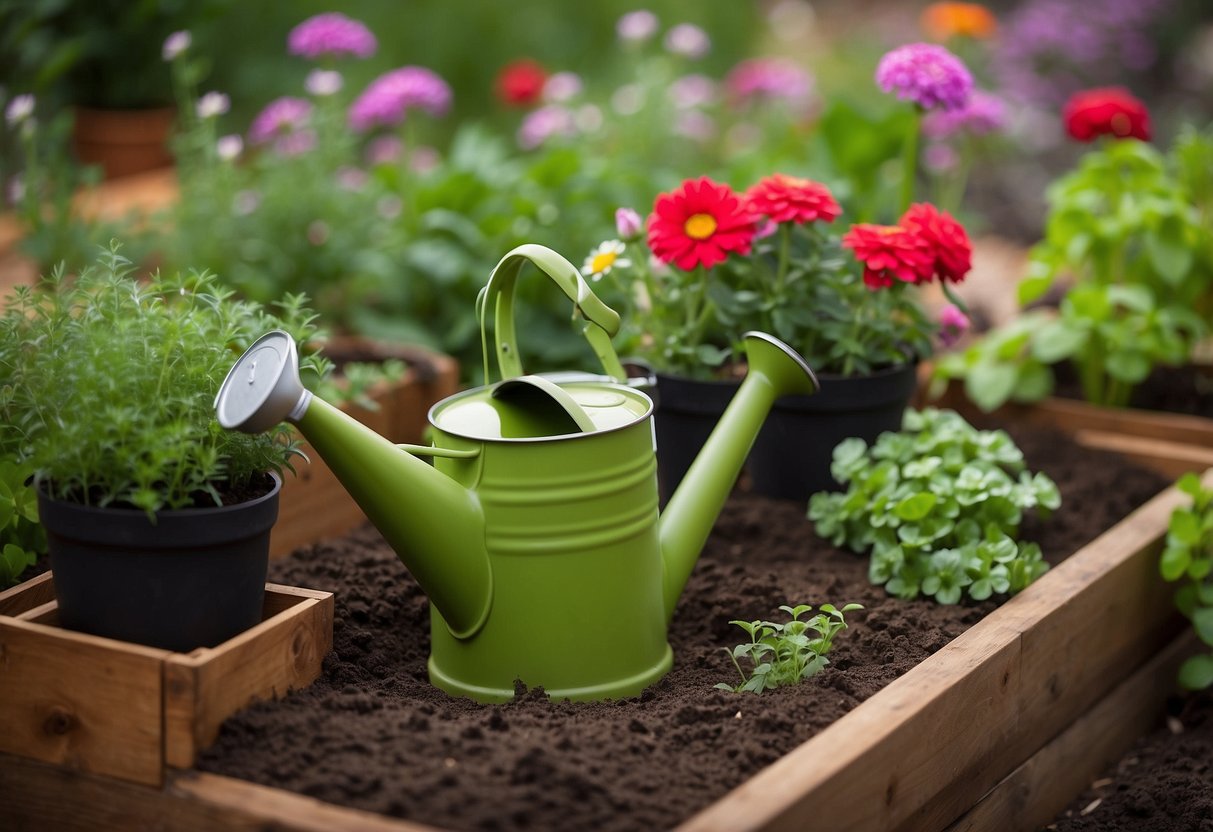
To keep your raised herb garden thriving, pay close attention to how you water it and perform important seasonal tasks. These steps will help ensure your herbs grow healthy and productive.
Irrigation Techniques
Proper watering is essential for your raised herb garden. Herbs generally prefer well-drained soil. Overwatering can lead to root rot, while underwatering can cause the plants to wilt and die.
A drip irrigation system is very effective. It delivers water directly to the soil, reducing waste and ensuring that your plants get the moisture they need. You can also use a simple soaker hose to keep the soil consistently moist.
Water your herbs in the early morning. This helps prevent evaporation and allows the plants to absorb water throughout the day. Check the soil moisture regularly. If the top 2 inches of soil are dry, it’s time to water.
Seasonal Maintenance Tips
Your raised herb garden needs different care depending on the season. In spring, remove any weeds and add a fresh layer of compost to enrich the soil. Trim dead or damaged leaves to encourage new growth.
In summer, mulch can help retain moisture and keep roots cool. Harvest herbs frequently to promote bushier growth. Watch for pests like aphids and treat them promptly.
In fall, cut back perennial herbs like rosemary and sage. This helps them survive the winter. Cover your bed with a frost-proof cloth if you expect cold weather. Keep the area clean to prevent pests from overwintering.
In winter, reduce watering since most herbs are dormant. Monitor them for frost damage and remove it if necessary. Store tools and irrigation equipment to protect them from frost.







